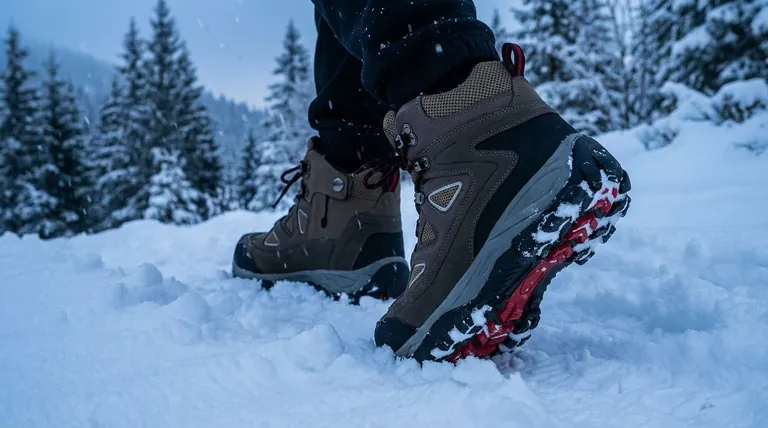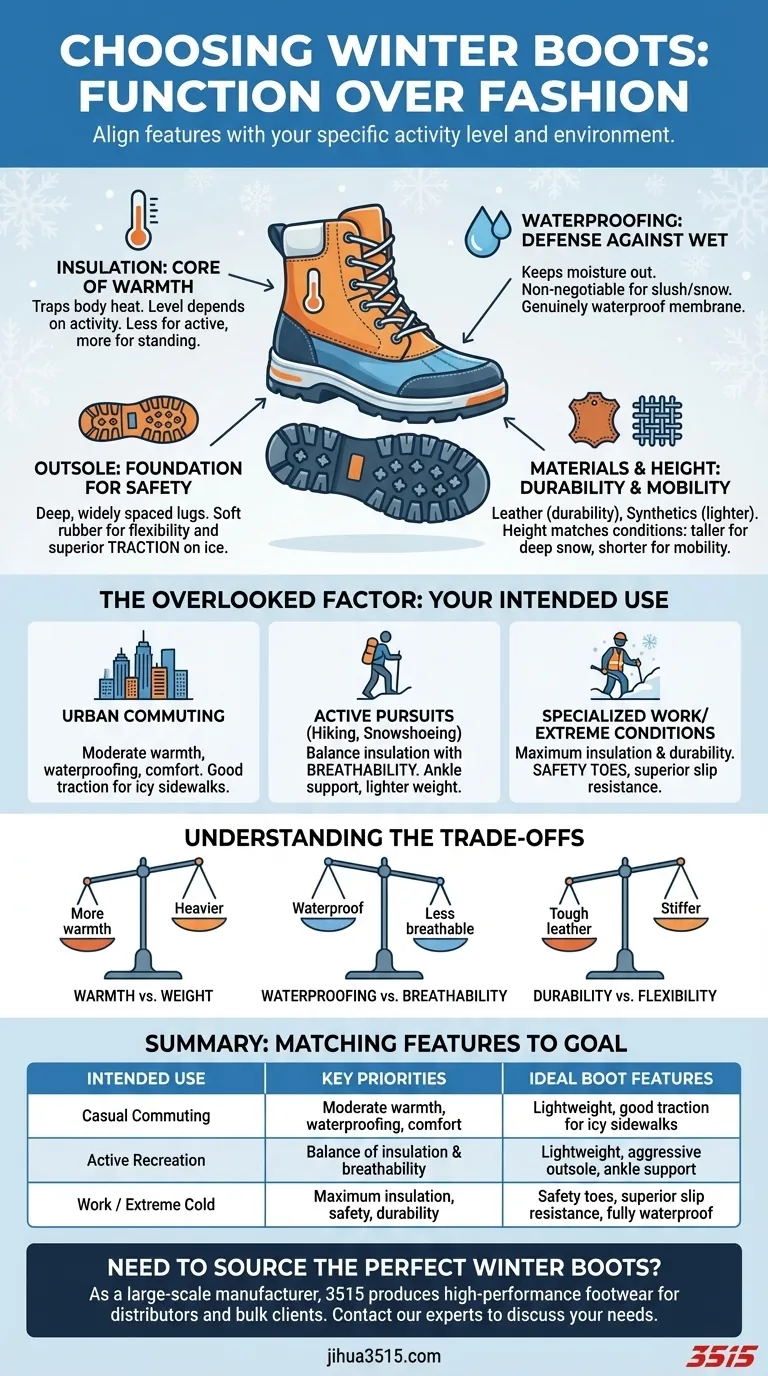Choosing the right winter boot is a matter of function, not just fashion. The most critical factors to consider are insulation for warmth, waterproofing for dryness, and outsole design for reliable traction on ice and snow. However, the best boot is not the one with the most features, but the one whose features are correctly aligned with your specific activity level and environment.
The ideal winter boot isn't the one with the maximum rating, but the one whose features precisely match your intended use. Before evaluating insulation or materials, first define your primary activity—whether it's daily commuting, active recreation, or specialized work.

Deconstructing the Anatomy of a Winter Boot
To make an informed decision, you must first understand the key components that determine a boot's performance. Each element serves a distinct purpose in protecting your feet from the cold.
Insulation: The Core of Warmth
Insulation is the thermal barrier that keeps your feet warm. It traps your body heat and prevents the cold from penetrating the boot.
The level of insulation you need depends entirely on your activity and personal sensitivity to cold. A boot for active hiking requires less insulation than one used for standing still in freezing temperatures.
Waterproofing: Your Defense Against Wet and Cold
Staying dry is as crucial as staying warm, as moisture rapidly pulls heat away from your body. Look for boots with a genuinely waterproof membrane or construction, not just "water-resistant" materials.
This feature is non-negotiable for environments with slush, deep snow, or freezing rain, as it forms an impenetrable barrier against external moisture.
The Outsole: Your Foundation for Safety
The outsole, or the bottom of the boot, is your point of contact with the ground. Its design is critical for preventing slips and falls on icy or snowy surfaces.
A proper winter outsole features deep, widely spaced lugs made of a softer rubber compound that remains flexible in the cold, providing superior traction and grip.
Materials and Height: Balancing Durability and Mobility
The upper part of the boot can be made from leather, synthetics like Cordura, or a combination. Leather offers excellent durability, while synthetics are often lighter and require less break-in time.
The height of the boot should match your conditions. Taller boots are necessary for deep snow, while shorter boots offer more mobility for casual wear or less severe weather.
The Most Overlooked Factor: Your Intended Use
The single most important step is to define how you will use your boots. A boot designed for one activity can be a poor choice for another.
For Casual Commuting and Daily Wear
For city streets and daily errands, the focus should be on a balance of moderate warmth, waterproofing, and comfort. Style is a valid consideration here, but it should not compromise these core functions.
For Active Pursuits (Hiking, Snowshoeing)
Active use generates significant body heat. For these activities, you need a boot that balances insulation with breathability to allow sweat to escape. Ankle support and a lighter overall weight are also critical for comfort over long distances.
For Specialized Work or Extreme Conditions
If your work requires standing outdoors for long periods or you face extreme cold, you need maximum insulation and durability. Features like safety toes (steel or composite) and superior slip resistance become primary requirements.
Understanding the Trade-offs
No single boot excels in every category. Choosing the right one means understanding the inherent compromises.
Warmth vs. Weight
More insulation means more warmth, but it also adds bulk and weight. An extremely warm boot can feel heavy and fatiguing during high-exertion activities like hiking.
Waterproofing vs. Breathability
A fully waterproof boot is excellent at keeping moisture out, but it can also trap sweat inside. For high-output activities, this can lead to damp socks and, paradoxically, colder feet.
Durability vs. Flexibility
Tough, rugged materials like full-grain leather offer maximum longevity but can be stiff and require a significant break-in period. Lighter synthetic materials often provide better flexibility and comfort right out of the box but may not last as long under heavy use.
Making the Right Choice for Your Goal
To simplify your decision, match the boot's primary characteristics to your goal.
- If your primary focus is urban commuting and general wear: Prioritize moderate insulation, reliable waterproofing, and a comfortable, lightweight design with good traction for icy sidewalks.
- If your primary focus is active winter recreation: Seek a balance of insulation and breathability in a lighter boot with excellent ankle support and an aggressive outsole.
- If your primary focus is demanding work or extreme cold: Invest in boots with maximum insulation, certified safety features, and a durable, fully waterproof construction built for long-term wear.
By matching the boot’s technical features to your specific needs, you ensure your feet remain warm, dry, and secure all winter long.
Summary Table:
| Intended Use | Key Priorities | Ideal Boot Features |
|---|---|---|
| Casual Commuting | Moderate warmth, waterproofing, comfort | Lightweight, good traction for icy sidewalks |
| Active Recreation | Balance of insulation & breathability | Lightweight, aggressive outsole, ankle support |
| Work / Extreme Cold | Maximum insulation, safety, durability | Safety toes, superior slip resistance, fully waterproof |
Need to source the perfect winter boots for your market? As a large-scale manufacturer, 3515 produces a comprehensive range of high-performance footwear for distributors, brand owners, and bulk clients. Our production capabilities encompass all types of insulated, waterproof, and safety-rated boots designed for any climate or activity. Let us help you find or create the ideal product for your customers. Contact our experts today to discuss your needs.
Visual Guide

Related Products
- Safety Footwear Wholesale Manufacturer for Custom OEM/ODM Production
- Wholesale Safety Footwear Manufacturer for Bulk & Custom OEM Orders
- Premium Wholesale Waterproof Safety Boots High Performance Protection for Industrial Markets
- Customizable Anti-Smash Safety Boots for Wholesale & Private Label Manufacturing
- High Performance Fire-Retardant Waterproof Safety Boots
People Also Ask
- How do safety shoes contribute to cost savings for companies? A Strategic Investment in Risk and Cost Management
- Is safety-toe as good as steel toe? Choose the Right Protection for Your Job
- What are OSHA approved shoes? Understanding the Correct Standards for Workplace Safety
- What are the cultural perspectives on wearing shoes in the house? A Guide to Home Etiquette & Hygiene
- Do snake bite boots work? Your Ultimate Guide to Effective Snake Bite Protection



















